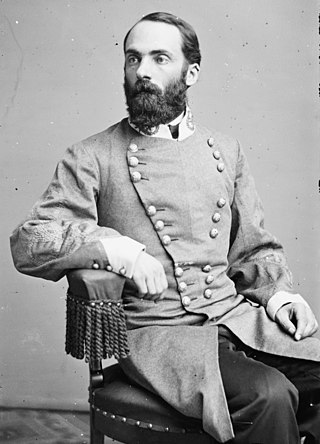
Joseph "Fighting Joe" Wheeler was a military commander and politician of the Confederate States of America. He was a cavalry general in the Confederate States Army in the 1860s during the American Civil War, and then a general in the United States Army during both the Spanish-American and Philippine–American Wars near the turn of the twentieth century. For much of the Civil War, he was the senior cavalry general in the Army of Tennessee and fought in most of its battles in the Western Theater.

The Battle of Stones River, also known as the Second Battle of Murfreesboro, was fought from December 31, 1862, to January 2, 1863, in Middle Tennessee, as the culmination of the Stones River Campaign in the Western Theater of the American Civil War. Of the major battles of the war, Stones River had the highest percentage of casualties on both sides. The battle ended in Union victory after the Confederate army's withdrawal on January 3, largely due to a series of tactical miscalculations by Confederate Gen. Braxton Bragg, but the victory was costly for the Union army. Nevertheless, it was an important victory for the Union because it provided a much-needed boost in morale after the Union's recent defeat at Fredericksburg and also reinforced President Abraham Lincoln's foundation for issuing the Emancipation Proclamation, which ultimately discouraged European powers from intervening on the Confederacy's behalf.
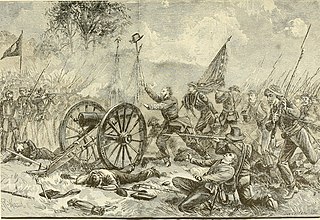
Pickett's Charge was an infantry assault on 3 July 1863, during the Battle of Gettysburg. It was ordered by Confederate General Robert E. Lee as part of his plan to break through Union lines and achieve a decisive victory in the North. The charge was named after Major General George Pickett, one of the Confederate Army's division commanders. The assault was aimed at the center of the Union Army's position on Cemetery Ridge, which was believed to be a vulnerable point in the Union defenses. As the Confederate troops marched across nearly a mile of open ground, they came under heavy artillery and rifle fire from entrenched Union forces. The open terrain offered little cover, making the Confederate soldiers easy targets, and their ranks were quickly decimated. Although a small number of the Confederate soldiers managed to reach the Union lines and engage in hand-to-hand combat, they were ultimately overwhelmed. The charge ended in a disastrous defeat for the Confederates, with more than half of the men involved either killed, wounded, or captured. Pickett's Charge marked the climax of the Battle of Gettysburg. The failure of the charge crushed the Confederate Army's hopes of winning a decisive victory in the North and forced General Lee to retreat back to Virginia.

The Army of Tennessee was the principal Confederate army operating between the Appalachian Mountains and the Mississippi River during the American Civil War. Named for the State of Tennessee, It was formed in the same state in late 1862 and fought until the end of the war in 1865, participating in most of the significant battles in the Western Theater.
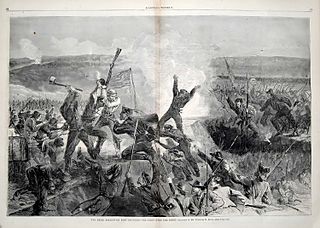
The Battle of Fort Sanders was the crucial engagement of the Knoxville Campaign of the American Civil War, fought in Knoxville, Tennessee, on November 29, 1863. Assaults by Confederate Lt. Gen. James Longstreet failed to break through the defensive lines of Union Maj. Gen. Ambrose Burnside, resulting in lopsided casualties, and the Siege of Knoxville entered its final days.
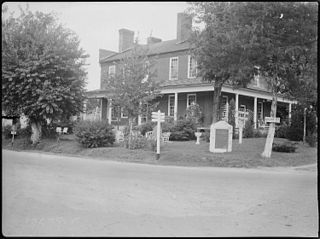
The Battle of Bean's Station was fought in Grainger County, Tennessee, during the Knoxville campaign of the American Civil War. The action saw Confederate forces commanded by Lieutenant General James Longstreet attack Union Army cavalry led by Brigadier General James M. Shackelford. After a clash that lasted until nightfall, Longstreet's troops compelled the Federals to retreat. Two cavalry columns that were intended to envelop Shackelford's force were unable to cut off the Union cavalry, though one of the columns captured 25 Federal wagons. On December 15, Shackelford was joined by some Union infantry southwest of Bean's Station where they skirmished with the Confederates before withdrawing again.

The Battle of Campbell's Station saw Confederate forces under Lieutenant General James Longstreet attack Union troops led by Major General Ambrose Burnside at Campbell's Station, Knox County, Tennessee, during the Knoxville Campaign of the American Civil War. Longstreet hoped to crush the Union Army of the Ohio forces before they could retreat to Knoxville. During the fighting, the Confederates forced the Union troops to fall back from five separate positions. However, the final result was that Burnside's troops conducted a successful fighting withdrawal.

The siege of Knoxville saw Lieutenant General James Longstreet's Confederate forces besiege the Union garrison of Knoxville, Tennessee, led by Major General Ambrose Burnside, in the American Civil War. When Major General William T. Sherman approached Knoxville with an overwhelming Union force, Longstreet ended the siege on December 4 and withdrew northeast. The siege was part of the Knoxville campaign of the Civil War.

The Knoxville campaign was a series of American Civil War battles and maneuvers in East Tennessee, United States, during the fall of 1863, designed to secure control of the city of Knoxville and with it the railroad that linked the Confederacy east and west, and position the First Corps under Lt. Gen. James Longstreet for return to the Army of Northern Virginia. Union Army forces under Maj. Gen. Ambrose Burnside occupied Knoxville, Tennessee, and Confederate States Army forces under Longstreet were detached from Gen. Braxton Bragg's Army of Tennessee at Chattanooga to prevent Burnside's reinforcement of the besieged Federal forces there. Ultimately, Longstreet's Siege of Knoxville ended when Union Maj. Gen. William Tecumseh Sherman led elements of the Army of the Tennessee and other troops to Burnside's relief after Union troops had broken the Confederate siege of Chattanooga. Although Longstreet was one of Gen. Robert E. Lee's best corps commanders in the East in the Army of Northern Virginia, he was unsuccessful in his attempt to penetrate the Knoxville defenses and take the city.

Horace Capron was an American businessman and agriculturalist, a founder of Laurel, Maryland, a Union officer in the American Civil War, the United States secretary of agriculture under U.S. presidents Andrew Johnson and Ulysses S. Grant, and an advisor to Japan's Hokkaidō Development Commission. His collection of Japanese art and artifacts was sold to the Smithsonian Institution after his death.

Hylan Benton Lyon was a career officer in the United States Army until the start of the American Civil War, when he resigned rather than fight against the South. As a Confederate brigadier general, he led a daring cavalry raid into Kentucky in December 1864, in which his troops burned seven county courthouses which were being used as barracks by the Union Army.

The First Corps, Army of Northern Virginia (or Longstreet's Corps) was a military unit fighting for the Confederate States of America in the American Civil War. It was formed in early 1861 and served until the spring of 1865, mostly in the Eastern Theater. The corps was commanded by James Longstreet for most of its existence.
The 10th Kentucky Infantry Regiment was a three-year volunteer infantry regiment that served in the U.S., or Union Army during the American Civil War.

The following Union Army units and commanders fought in the Knoxville Campaign and subsequent East Tennessee operations during the American Civil War from November 4 to December 23, 1863 under the command of Maj. Gen. Ambrose E. Burnside. Engagements fought during this time included the battles of Campbell's Station and Fort Sanders and the siege of Knoxville. Order of battle compiled from the army organization during the campaign and return of casualties. The Confederate order of battle is shown separately.

James Patton Brownlow was a Union Army officer during the American Civil War. Brownlow was the son of East Tennessee preacher and politician Parson Brownlow. James P. Brownlow served in several positions in the Union Army, finishing the war as colonel of the 1st Tennessee Cavalry Regiment. He was noted for his courage and perceptiveness in battle and keen sense of military tactics. Union cavalry in Tennessee, in addition to participating in crucial organized battles of the war, "primarily meant almost endless skirmishing with partisans, guerrillas, and bushwackers, as well as with the Rebel raiders of John Hunt Morgan, Joseph Wheeler, and Nathan Bedford Forrest, who frequently recruited and supplied themselves from behind enemy lines." Jim Brownlow's deft handling of these engagements left him with a reputation as "one of the greatest daredevils of the Civil War."
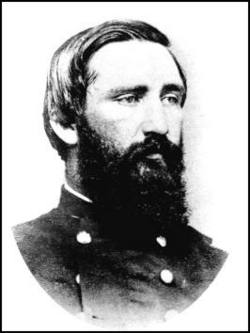
Sanders' Knoxville Raid saw 1,500 Union cavalry and mounted infantry led by Colonel William P. Sanders raid East Tennessee before the Knoxville campaign during the American Civil War. The successful raid began at Mount Vernon, Kentucky and moved south, passing near Kingston, Tennessee. Moving east from the Kingston area, the raiders struck the East Tennessee and Georgia Railroad at Lenoir Station. The Union horsemen rode northeast along the railroad, destroying track, bridges, and property useful to the Confederate States of America. Blocked from seizing Knoxville by its 1,000 Confederate defenders, Sanders' horsemen destroyed a major bridge across the Holston River at Strawberry Plains on the East Tennessee and Virginia Railroad. After wrecking a smaller bridge at Mossy Creek, the raiders turned northwest, evading pursuers by slipping through an obscure gap in the Cumberland Plateau. Sanders' men reached Boston, Kentucky on June 24, having captured and paroled over 400 Confederate soldiers while sustaining minimal losses in men but considerable losses in horses.

The Battle of Philadelphia saw the Confederate cavalry brigades of Colonels J. J. Morrison and George Gibbs Dibrell attack a Union cavalry brigade under Colonel Frank Wolford at Philadelphia, Tennessee, during the Knoxville campaign of the American Civil War. While Dibrell's brigade skirmished with Wolford's cavalrymen, Morrison led his brigade around the west side of Philadelphia to attack the Union force from the rear. Wolford sent half his brigade to counter Morrison's envelopment, but Dibrell's soldiers suddenly attacked. The Confederates completely routed Wolford's troopers, capturing over 400. A Union infantry-cavalry force reoccupied Philadelphia the next day, but a week later it withdrew to the north bank of the Tennessee River, abandoning Loudon, Tennessee.

The Battle of Walker's Ford saw three Confederate cavalry brigades led by Brigadier General William T. Martin attack a Union cavalry brigade under Colonel Felix W. Graham at Walker's Ford on the Clinch River during the Knoxville campaign of the American Civil War. After failing to trap Graham's brigade at Maynardville, Tennessee, Martin's cavalry pursued in the direction of Tazewell before encountering Graham's horsemen south of Walker's Ford in the morning. At first, Martin's cavalry pressed Graham's troopers back. However, Brigadier General Orlando B. Willcox arrived with a Union infantry brigade and repulsed the Confederate cavalry. Martin sent a cavalry brigade to envelop the Union force, but it was blocked by one of Graham's regiments at a nearby ford. Martin's Confederates soon withdrew toward Knoxville. Willcox's tentative probe failed to relieve Major General Ambrose Burnside's defenders in the Siege of Knoxville, but Major General William T. Sherman's much larger forces soon accomplished that task.
Henry Benedict Mattingly was a Union Army soldier in the American Civil War and a recipient of the United States military's highest decoration, the Medal of Honor, for his actions at the September 1, 1864, Battle of Jonesborough, Georgia.

The Madison Louisiana Light Artillery was a Louisiana artillery unit that fought in the Confederate States Army during the American Civil War. Formed as an infantry company, it arrived in the Eastern Theater in May 1861 and was converted to an artillery battery in August. The unit was armed with six guns in 1861, but by September 1862, it had only four guns. It served at Garnett's and Golding's Farm, Savage's Station, Second Bull Run, Antietam, and Fredericksburg in 1862. The battery fought at Chancellorsville and Gettysburg and in the Knoxville campaign in 1863. The Madison Light Artillery served in the Overland campaign and at the Siege of Petersburg in 1864. The unit surrendered at Appomattox in April 1865.


















